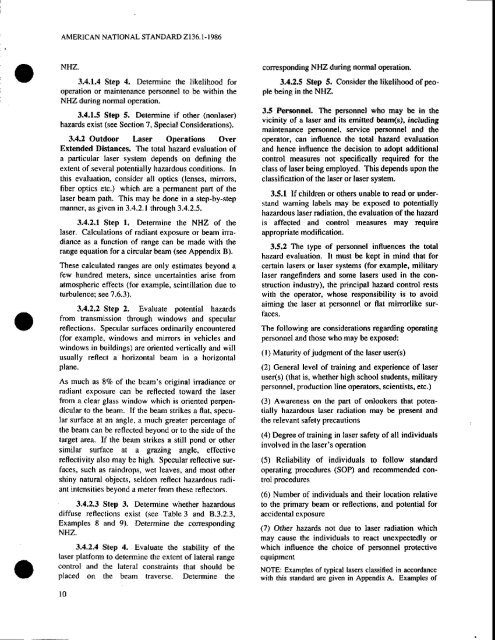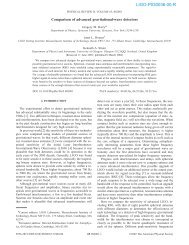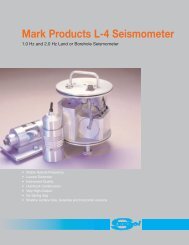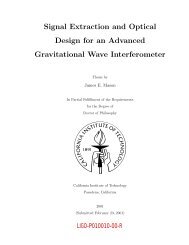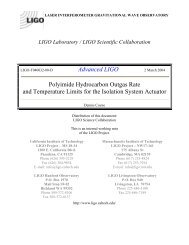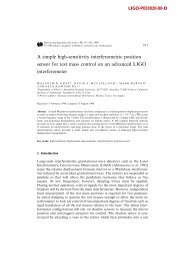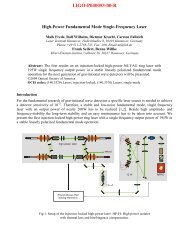for the sqfe use of lqsers - LIGO
for the sqfe use of lqsers - LIGO
for the sqfe use of lqsers - LIGO
You also want an ePaper? Increase the reach of your titles
YUMPU automatically turns print PDFs into web optimized ePapers that Google loves.
AMERICAN NATIONAL STANDARD 2I36. I. I 986<br />
NHZ.<br />
3.4.1.4 Slep 4. Determine <strong>the</strong> likelihood <strong>for</strong><br />
operation or maintenance personnel to be within <strong>the</strong><br />
NHZ during normal operation.<br />
3.4.15 Step 5. Determine if o<strong>the</strong>r (nonlas€r)<br />
hazards exist (see Section ?, Special Considerations),<br />
3,4.2 Outdoor Laser Operaaions Over<br />
Extended Distances. The total hazard evaluation <strong>of</strong><br />
a particular laser system depends on defining <strong>the</strong><br />
extent <strong>of</strong> several potentially hazardous conditions. In<br />
this evaluation, consider all optics (lenses, mirrors,<br />
fiber optics etc.) which are a permanent part <strong>of</strong> lhe<br />
laser beam path. This may be done in a step-by-step<br />
manner, as given in 3.4.2.I through 3.4.2.5.<br />
3.4.2.1 Step l Determine <strong>the</strong> NHZ <strong>of</strong> <strong>the</strong><br />
laser, Calculations <strong>of</strong> radiant exposure or beam irradiance<br />
as a function <strong>of</strong> ftrnge can be made with <strong>the</strong><br />
raDge equation <strong>for</strong> a circular beam (see Appendix B).<br />
These calculated ranges are only estimates beyond a<br />
few hundred meters. since uncertainties arise from<br />
atmospheric effects (<strong>for</strong> example, scintillation due to<br />
turbulence; see ?,6.3).<br />
3.4.2.2 Step 2. Evaluate potential hazards<br />
from transmission through windows and specular<br />
reflections, Specular surfaces ordinarily encountered<br />
(<strong>for</strong> example, windows and mirrors in vehicles and<br />
windows in buildings) arc oriented vertically and will<br />
usually reflect a horizontal beam in a horizontal<br />
plane.<br />
As much as 89o <strong>of</strong> <strong>the</strong> beam's original inadiance or<br />
radiant exposure can be reflected toward <strong>the</strong> laser<br />
from a clear glass window which is oriented perpendicular<br />
to <strong>the</strong> beam. If <strong>the</strong> beam strikes a flat, specular<br />
surface at an angle, a much greater percentage <strong>of</strong><br />
<strong>the</strong> beam can be reflected beyond or to <strong>the</strong> side <strong>of</strong> <strong>the</strong><br />
target area. If <strong>the</strong> beam strikes a still pond or o<strong>the</strong>r<br />
similar surface at a grazing angle, effective<br />
reflectivity also may be high. Specular reflective surfaces,<br />
such as raindrops, wet leaves, and most o<strong>the</strong>r<br />
shiny natural objects, seldom reflect hazardous radiant<br />
intensities beyond a meter from <strong>the</strong>sc reflectors.<br />
3.4.2.3 Step 3. Determine whe<strong>the</strong>r hazardous<br />
diff<strong>use</strong> reflections exist (see Table 3 and 8.3.2.3,<br />
Examples 8 and 9). Determine <strong>the</strong> coresponding<br />
NHZ.<br />
3.4.2.4 Step 4. Evaluate <strong>the</strong> stabiliry <strong>of</strong> rhe<br />
laser platfom to determine <strong>the</strong> extent <strong>of</strong> lateral range<br />
control and <strong>the</strong> lateral constraints that should be<br />
placed on <strong>the</strong> beam traverse. Determine <strong>the</strong><br />
l0<br />
corresponding NHZ during normal operatlon.<br />
3.4.2.5 Step 5, Consider <strong>the</strong> likelihood <strong>of</strong> people<br />
being in <strong>the</strong> NHZ.<br />
3.5 Personn€I. The personnel who may b€ in <strong>the</strong><br />
vicinity <strong>of</strong> a laser and its emitted beam(s), including<br />
maintenance personnel, service personnel and <strong>the</strong><br />
operator, can influence <strong>the</strong> total hazard evaluation<br />
and hence influence <strong>the</strong> decision to adopt additional<br />
control measures not specifically required <strong>for</strong> <strong>the</strong><br />
class <strong>of</strong> laser being employed. This depends upon <strong>the</strong><br />
classification <strong>of</strong> <strong>the</strong> laser or laser system.<br />
35.1 If children or o<strong>the</strong>rs unable to read or und€rstand<br />
waming labels may be exposed to potentially<br />
hazardous laser radiation, <strong>the</strong> evaluation <strong>of</strong> <strong>the</strong> hazard<br />
is affected and control measures may require<br />
appropriate modifi cation.<br />
3.5.2 The type <strong>of</strong> personnel influences <strong>the</strong> total<br />
hazard evaluation. It must be kept in mind that <strong>for</strong><br />
certain lasers or laser systems (<strong>for</strong> example, military<br />
laser rangefinders and some lasers <strong>use</strong>d in <strong>the</strong> construction<br />
industry), <strong>the</strong> principal hazard conrol rests<br />
with <strong>the</strong> operator, whose responsibility is to avoid<br />
aiming <strong>the</strong> laser at personnel or flat mirrorlike surfaces.<br />
The following are considerations regarding operating<br />
personnel and those who may be exposed:<br />
( | ) Maturity <strong>of</strong>judgment <strong>of</strong> <strong>the</strong> laser <strong>use</strong>r(s)<br />
(2) General level <strong>of</strong> training and experience <strong>of</strong> laser<br />
<strong>use</strong>r(s) (that is, whe<strong>the</strong>r high school students, military<br />
personnel, production line operators, scientists, etc.)<br />
(3) Awareness on <strong>the</strong> part <strong>of</strong> onlookers that potentially<br />
hazardous laser radiation may b€ present and<br />
<strong>the</strong> relevant safety precautions<br />
(4) Degree <strong>of</strong> training in laser safety <strong>of</strong> all individuals<br />
involved in <strong>the</strong> laser's operation<br />
(5) Reliability <strong>of</strong> individuals to follow standard<br />
operating procedures (SOP) and recommended control<br />
procedures<br />
(6) Number <strong>of</strong> individuals and <strong>the</strong>ir location relative<br />
to <strong>the</strong> pdmary beam or reflections, and potential <strong>for</strong><br />
accidental exposure<br />
(71 O<strong>the</strong>r hazards not due to laser radiation which<br />
may ca<strong>use</strong> <strong>the</strong> individuals to rEact unexpectedly or<br />
which influence <strong>the</strong> choice <strong>of</strong> personnel protective<br />
equipment<br />
NOTE: Examples <strong>of</strong> typical lasers classified in accordance<br />
with this standard are given in Appendix A. Examples <strong>of</strong>


